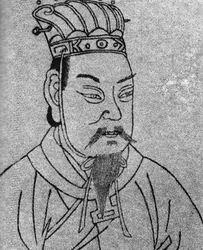China discovers tomb of famed general Cao Cao
2009-12-27 17:06 BJT
Archeologists have discovered a sprawling tomb complex near the ancient city of Anyang, in Henan Province. After consulting historical documents and comparing other cultural relics, they say the tomb most likely belonged to Cao Cao, a prominent figure during ancient China's Three Kingdoms period more than 2,000 years ago.
The elaborate tomb covers 800 square meters, with a 38-meter passage leading to an underground chamber.

Archeologists say the site had been repeatedly robbed over the centuries. However, inscriptions on surviving iron and stone artifacts suggest that the tomb's occupant was high-ranking.
Pan Wenbin, Archeologist, said, "We have found one tapering jade tablet, which is an indicator of a tomb's level. Only emperors' tombs contain such burial articles. Inscriptions on the tablet also suggests its owner could be Cao Cao. "
Experts have consulted various historical documents, such as The History of the Three Kingdoms, for clues to Cao Cao's life.
They know that Cao Cao once issued an order concerning where he was to be buried after he died. The description roughly corresponds to the discovered tomb's location.
Experts also retrieved three skulls from the burial site. Forensic analysis revealed one of them belonged to a male about 66 years of age. Cao Cao is said to have died at 66.
Other objects found at the site included a sword and scabbard. They are being treated for future study.
If the tomb is indeed Cao Cao's, archeologists hope that by studying the artifacts contained within, they can flesh out the life and personality of the legendary Chinese ruler.
2009-12-27 17:06 BJT
Archeologists have discovered a sprawling tomb complex near the ancient city of Anyang, in Henan Province. After consulting historical documents and comparing other cultural relics, they say the tomb most likely belonged to Cao Cao, a prominent figure during ancient China's Three Kingdoms period more than 2,000 years ago.
The elaborate tomb covers 800 square meters, with a 38-meter passage leading to an underground chamber.

Archeologists say the site had been repeatedly robbed over the centuries. However, inscriptions on surviving iron and stone artifacts suggest that the tomb's occupant was high-ranking.
Pan Wenbin, Archeologist, said, "We have found one tapering jade tablet, which is an indicator of a tomb's level. Only emperors' tombs contain such burial articles. Inscriptions on the tablet also suggests its owner could be Cao Cao. "
Experts have consulted various historical documents, such as The History of the Three Kingdoms, for clues to Cao Cao's life.
They know that Cao Cao once issued an order concerning where he was to be buried after he died. The description roughly corresponds to the discovered tomb's location.
Experts also retrieved three skulls from the burial site. Forensic analysis revealed one of them belonged to a male about 66 years of age. Cao Cao is said to have died at 66.
Other objects found at the site included a sword and scabbard. They are being treated for future study.
If the tomb is indeed Cao Cao's, archeologists hope that by studying the artifacts contained within, they can flesh out the life and personality of the legendary Chinese ruler.








